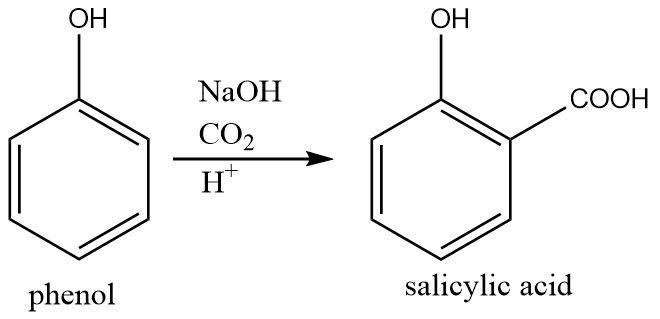
How is phenol converted to salicylic acid?
Answer
409.2k+ views
Hint :Benzene attached to a hydroxyl functional group is called phenol. Salicylic acid is a derivative of phenol itself with an additional carboxylic acid functional group attached to a position ortho to the hydroxyl group of phenol.
Complete Step By Step Answer:
Salicylic acid is an important industrial organic compound that can be derived from phenol through two different types of reactions. It contains the same structure as that of phenol with an additional carboxylic acid group $ (COOH) $ placed at the ortho position (adjacent position) of the hydroxyl group of phenol.
The two methods of converting phenol to salicylic acid are as follows:
Kolbe-Schmitt reaction: This reaction involves the conversion of acidic phenol into a phenoxide ion in presence of sodium hydroxide base. This is followed by the attack of phenoxide ion of the electrophilic carbon dioxide gas resulting in a carboxylate group getting attached at the ortho position. The reaction ends with a mild acidic hydrolysis that gives salicylic acid.
Thus it is a base facilitated carboxylation of phenol.
The overall reaction can be written as follows:
$ {\text{phenol}}\xrightarrow[{{H^ + }}]{\begin{subarray}{l}
NaOH \\
C{O_2}
\end{subarray} }{\text{salicylic acid}} $

Reimer–Tiemann reaction: This reaction involves the conversion of phenol to salicylic acid by treatment of phenol at high temperatures with carbon tetrachloride in the presence of an alkali followed by mild hydrolysis.
The reaction can be written as follows:
$ {\text{phenol}}\xrightarrow[{{H_2}O}]{\begin{subarray}{l}
NaOH \\
CC{l_4}
\end{subarray} }{\text{salicylic acid}} $

Note :
The Reimer–Tiemann reaction can be performed with both chloroform as well as carbon tetrachloride. The reaction in the presence of chloroform as a reagent gives salicylaldehyde, however that in the presence of carbon tetrachloride gives salicylic acid as the desired product.
Complete Step By Step Answer:
Salicylic acid is an important industrial organic compound that can be derived from phenol through two different types of reactions. It contains the same structure as that of phenol with an additional carboxylic acid group $ (COOH) $ placed at the ortho position (adjacent position) of the hydroxyl group of phenol.
The two methods of converting phenol to salicylic acid are as follows:
Kolbe-Schmitt reaction: This reaction involves the conversion of acidic phenol into a phenoxide ion in presence of sodium hydroxide base. This is followed by the attack of phenoxide ion of the electrophilic carbon dioxide gas resulting in a carboxylate group getting attached at the ortho position. The reaction ends with a mild acidic hydrolysis that gives salicylic acid.
Thus it is a base facilitated carboxylation of phenol.
The overall reaction can be written as follows:
$ {\text{phenol}}\xrightarrow[{{H^ + }}]{\begin{subarray}{l}
NaOH \\
C{O_2}
\end{subarray} }{\text{salicylic acid}} $

Reimer–Tiemann reaction: This reaction involves the conversion of phenol to salicylic acid by treatment of phenol at high temperatures with carbon tetrachloride in the presence of an alkali followed by mild hydrolysis.
The reaction can be written as follows:
$ {\text{phenol}}\xrightarrow[{{H_2}O}]{\begin{subarray}{l}
NaOH \\
CC{l_4}
\end{subarray} }{\text{salicylic acid}} $

Note :
The Reimer–Tiemann reaction can be performed with both chloroform as well as carbon tetrachloride. The reaction in the presence of chloroform as a reagent gives salicylaldehyde, however that in the presence of carbon tetrachloride gives salicylic acid as the desired product.
Recently Updated Pages
The correct geometry and hybridization for XeF4 are class 11 chemistry CBSE

Water softening by Clarks process uses ACalcium bicarbonate class 11 chemistry CBSE

With reference to graphite and diamond which of the class 11 chemistry CBSE

A certain household has consumed 250 units of energy class 11 physics CBSE

The lightest metal known is A beryllium B lithium C class 11 chemistry CBSE

What is the formula mass of the iodine molecule class 11 chemistry CBSE

Trending doubts
Why was the Vernacular Press Act passed by British class 11 social science CBSE

Arrange Water ethanol and phenol in increasing order class 11 chemistry CBSE

Name the nuclear plant located in Uttar Pradesh class 11 social science CBSE

What steps did the French revolutionaries take to create class 11 social science CBSE

How did silk routes link the world Explain with three class 11 social science CBSE

What are the various challenges faced by political class 11 social science CBSE




